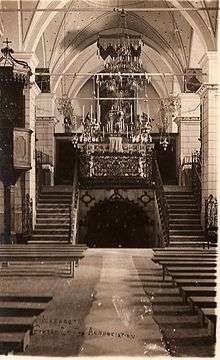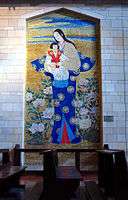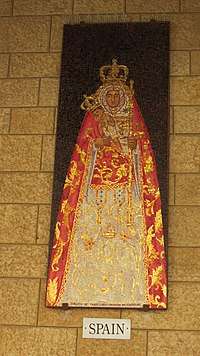Basilica of the Annunciation
| Church of the Annunciation | |
|---|---|
|
Front of the church | |
| Basic information | |
| Location | Nazareth, Israel |
| Affiliation | Roman Catholic |
| Year consecrated | 1969 |
| Ecclesiastical or organizational status | Minor Basilica |
| Completed | 1969 |
| Dome height (outer) | 55 Meters |
- This article refers to the basilica in Nazareth. For information on the church associated with the Blagoveschenskaya Tower in Russia, see Kremlin towers or Cathedral of the Annunciation.
The Church of the Annunciation (Hebrew: כנסיית הבשורה, Arabic: كنيسة البشارة, Greek: Εκκλησία του Ευαγγελισμού της Θεοτόκου, Ekklisía tou Evangelismoú tis Theotókou), sometimes also referred to as the Basilica of the Annunciation, is a church in Nazareth, in northern Israel. It was established over the site where the Catholic tradition holds to be the house of Virgin Mary, and where angel Gabriel appeared to her and announced that she would conceive and bear the Son of God, Jesus – an event known as the Annunciation. For this reason, the site and the city of Nazareth are among the most sacred places in the Christian world.
History
The church was established at the site where, according to Roman Catholic tradition, the Annunciation took place. Greek Orthodox tradition holds that this event occurred while Mary was drawing water from a local spring in Nazareth, and the Greek Orthodox Church of the Annunciation was erected at that alternate site.
The current church is a two-story building constructed in 1969 over the site of an earlier Byzantine-era and then Crusader-era church. Inside, the lower level contains the Grotto of the Annunciation, believed by many Christians to be the remains of the original childhood home of Mary. Under Roman Catholic canon law, the church enjoys the status of a minor basilica.[1] A historically significant site, considered sacred within some circles of Christianity, particularly Catholicism, the basilica attracts many Catholic, Anglican, and Eastern Orthodox Christian visitors every year.
The first shrine was probably built sometime in the middle of the 4th century, comprising an altar in the cave in which Mary had lived. A larger structure was commissioned by Emperor Constantine I, who had directed his mother, Saint Helena, to found churches commemorating important events in Jesus Christ's life. The Church of the Annunciation was founded around the same time as the Church of the Nativity (the birthplace) and the Church of the Holy Sepulchre (the tomb). Some version of it was known to have still been in existence around 570 AD, but it was destroyed in the 7th century after the Muslim conquest of Palestine.
The second church was built over the ruins of the Byzantine era church during the Crusades, following the conquest of Nazareth by Tancred in 1102.[2] The Crusader era church was never fully completed. Five Romanesque capitals carved by artists from northern France, and discovered during excavations in 1909, had not yet been installed in 1187 when news of Saladin's victory in the Battle of Hittin reached the city.[2] Saladin granted permission to Franciscan priests to remain in Nazareth to oversee services at the church.[2]

In 1260, Baybars and his Mamluk army destroyed the church during their attack on Nazareth.[2] A small number of Franciscans managed to stay in Nazareth until the fall of Acre in 1291. In the three centuries that followed, the Franciscans were in and out of Nazareth, depending on the local political situation, which was constantly in flux. Franciscan accounts of this period document their expulsion in 1363, their return in 1468 and a massacre of some of their members in 1542. Local Christian families with Franciscan support helped take care of the church as well during this period.[3]
Emir Fakr ad-Din granted the Franciscans permission to return in 1620, at which time they constructed a small structure to enclose the holy grotto that is venerated as the house of Mary.[3] In 1730, Zahir al-Umar permitted construction of a new church, which became a central gathering place for Nazareth Latin community. The church was enlarged in 1877, and then completely demolished in 1954 to allow for the construction of a new basilica, which was completed in 1969.[3] The new basilica was designed by the Italian architect Giovanni Muzio, and built by the Israeli building firm Solel Boneh during the years 1960-69. The Chief Engineer at this project was Ing. Shlomo Lopatin (Aluf) who was dedicated to the Basilica building process for more than 10 years, and it was indeed his life-project. the Used by the Latin parish, it remains under the control of the Franciscans. It is the largest Christian sanctuary in the Middle East, and was dedicated in 1964 by Pope Paul VI.
In this Basilica is a gallery with mosaics representing some of the most important Marian devotions in different countries. Among the Marian devotions in Spain include: The Virgin of Candelaria, patron saint of the Canary Islands,[4] the Virgin of Montserrat, patroness of Catalonia, the Virgin of the Forsaken, patroness of Valencia and the Virgin of Guadalupe, patroness of Extremadura.[5]
Gallery
- Catholic Mass in the Grotto of the Annunciation (lower level of the church).
 Japanese mosaic of Madonna and Child, in the upper level chapel of the church.
Japanese mosaic of Madonna and Child, in the upper level chapel of the church.- Front door of the church, depicting major events in Jesus' life.
- Night view of the Basilica of the Annunciation.
 Mosaic in the arcades of the Basilica.
Mosaic in the arcades of the Basilica. Mosaic depicting the Virgin of Candelaria (patron saint of the Canary Islands).
Mosaic depicting the Virgin of Candelaria (patron saint of the Canary Islands).
References
- ↑ http://www.adoremus.org/DomusEcclesiae.html
- 1 2 3 4 Emmett, 1995, p. 100.
- 1 2 3 Emmett, 1995, p. 101.
- ↑ Cristianos en Tierra Santa Archived 2014-12-05 at the Wayback Machine.
- ↑ La patrona extremeña será entronizada en la basílica de la Anunciación
Bibliography
- Emmett, Chad F (1995). Beyond the Basilica: Christians and Muslims in Nazareth. University of Chicago Press. ISBN 0-226-20711-0
- * Masha Halevi. "The Politics Behind the Construction of the Modern Church of the Annunciation in Nazareth." The Catholic Historical Review, Volume 96, Number 1, January 2010, pp.27-55
Other reading
- The Basilica of the Annunciation
- Day of Discovery: Three Marys Jesus Loved, 2006 CBS video documentary
- Nazareth places of interest
- The Catholic Encyclopedia, Nazareth
- Nazareth - The Basilica of the Annunciation, from the Israel Ministry of Foreign Affairs
- Mirezo: Holy Land Services for Christians Worldwide
- The Basilica of the Annunciation
| Wikimedia Commons has media related to Church of the Annunciation. |
Coordinates: 32°42′08″N 35°17′52″E / 32.70222°N 35.29778°E